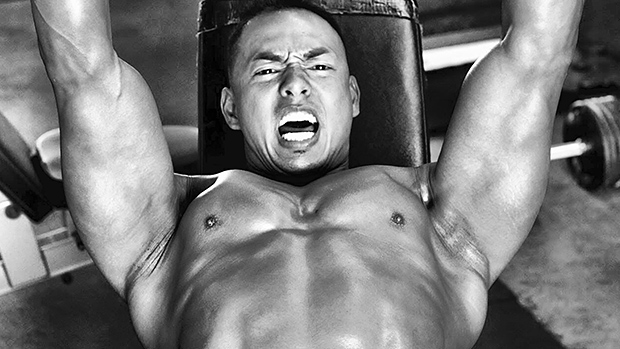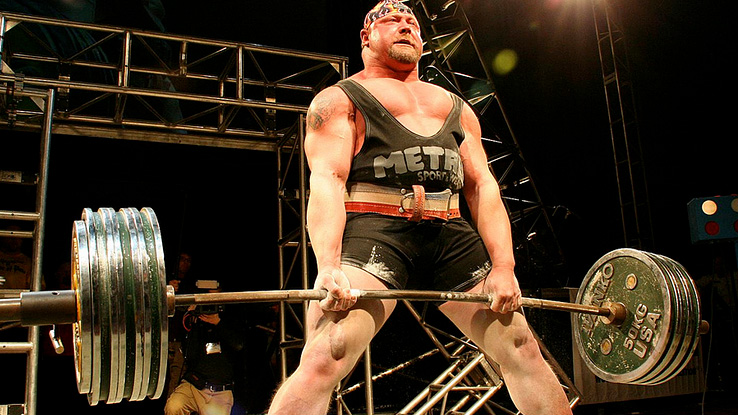Q: What type of diet would you recommend while using your 1-6-1 training program? In general, what would you suggest for anyone whose primary goal is to build strength?
A: In a nutshell, when interested in increasing your level of maximal strength (regardless of whether you're doing the 1-6-1 program or some other routine geared toward increasing strength), I find that supplements actually play a bigger part than diet. This, of course, is assuming that you're eating a diet that's more well-balanced than that eaten by the average guest on the Jerry Springer show.
Additionally, diets are very individual specific, and trying to prescribe a universal strength-building diet is risky. The key thing to keep in mind, however, in eating for maximal strength gains is focus, and anything that dulls your focus should immediately be kicked out of your diet with the deftness of an Irish barkeeper throwing out an unruly drunk. Personally, I have to abstain from carbs until the workout is over, even the low glycemic index ones. Contrast that with pro bodybuilder Milos Sarcev, however, who can ingest enough pasta to save a small African nation from starvation and still have a great workout. Compounds that I have found to help increase strength:
- Power Drive, not to exceed the recommended dosage
- Acetyl-l-carnitine, 3-7 grams per day
- Glutamine, 30-70 grams per day
- Branched-chain aminos/glutamine, taken while training, like Beverly International's Muscularity (800-781-3475)
- Methoxy-7, four tablespoons per day (I particularly like it for athletes who need to compete in weight classes, as it also allows them to lose bodyfat)
- Ribose/creatine combo, four servings per day
- Sufficient protein, two grams per pound of bodyweight (most individuals will need to use liquid meals to achieve this target)
- Plenty of smart fats like CLA and fish oils
- Certain forms of tocotrienols in high dosages (they also dramatically reduce cholesterol)
- Various herbal preparations (this goes beyond the scope of this column, I enlist the help of a naturopath trained in herbology)
I'm not suggesting that you take all of the previous compounds at once. But I do recommend that you experiment with some of them, either alone or in combination, and find what works best for you.
Q: What do you think of "jump squats"? If you like them, how would you recommend incorporating them into a program?
A: They're excellent for improving vertical-jump ability and shortening the "stance phase" in sprinting (the time you make contact with the ground; the shorter it is, the faster you're running).
The problem most people experience with this exercise is that they use loads that far exceed their stretch-shortening cycle capabilities. In other words, they spend way too much time on the ground, which negates the positive transfer of this exercise. Obviously, you can't load a bank vault on your back and expect to spring up with any degree of explosive power.
Studies on various track and field groups would tend to suggest that an athlete never use more than 40% of his or her best power snatch for this exercise. I normally use five to ten sets of six to ten reps on this exercise. The ground contact time has to be kept to a minimum. If the weight you're using doesn't allow you to immediately explode back up, your vertical jump is doomed to stay in the modest range. You'll be able to leap over any two-by-fours that bar your way with amazing deftness, but not much beyond that.
Q: Hey, Charles, I want traps like WCW wrestler Goldberg. I've never heard of a "trap specialization" program. Should I just do lots of shrugs and upright rows, or is there something better? Thanks for the advice! Think you could kick Goldberg's ass, shorty?
A: Yes, you can do a specialized trap routine. This muscle normally has a very rapid growth response, so much so that if you can't grow traps, you're truly destined for geekhood.
Submission fighters use plenty of trap work to improve their specific skills. Ultimate Fighting championship winner Ken Shamrock has a set of traps that most pro bodybuilders would envy.
Powerlifters get their trap development from years of deadlifting while the Olympic lifters get them simply from the Olympic lifts and their derivatives. In fact, British powerlifter and World Record Holder Vanessa Gibson has trap development that makes Goldberg look cachectic. Her breasts are nicer, too, but that's beside the point.
I'd rank the power snatch as the top trap builder. Then, power cleans and the different forms of shrugs. Here's a good 12- workout trap cycle that should pack the meat on:
Workouts 1-6 (Working traps every fifth day)
- A. Power snatch from mid-thigh
- Five sets of five to six reps on a 10X0 tempo, resting for three minutes between sets.
- Editor's note: The numbers in the tempo refer to how many seconds it should take you to do the rep, with the first number referring to the lowering portion of the rep and the second number referring to the pause, if any, between lowering and lifting. The third number denotes how long it should take you to lift the weight (an "X" denoting explosive speed) while the last number is the interim between lifting and lowering, if any.
- B. Trap tri-set
- Seated dumbbell shrugs, three sets of six to eight reps on a 2022 tempo
- Rest for ten seconds
- Standing barbell shrugs, three sets of 10-12 reps on a 1110 tempo (note a pause at the top of the movement)
- Rest for ten seconds
- Upright cable rows, three sets of 12-15 reps on a 2010 tempo
- Rest for two minutes
- Repeat all steps two more times
Workouts 7-12
- A. Power cleans from blocks
- Ten sets of two to three reps on a 10X0 tempo, resting for three minutes between sets
- B. Single-arm dumbbell shrugs
- Five sets of six to eight reps on a 2011 tempo, resting for three minutes between sets (single-arm shrugs allows for a greater range of motion)
Supplemental neck work is also indicated if you want to further thicken the neck. Regarding kicking Goldberg's ass, I don't mind fighting out of my weight class, but fighting out of my species is a completely different story.
Q: Could you give us some general guidelines as to how an athlete should train in-season as opposed to off-season? I know that can get complicated and can be sport-specific, but are there any "rules of thumb" to use as guidelines?
A: Here are some rules of thumb regarding in-season strength training: there's no need for so-called specific work. You're already doing plenty of that on the field, or on the ice. I know of one team who chose to do "sport-specific training" during the season. Eleven out of fourteen athletes developed patellar tendonitis in a short amount of time.
It takes very little work to maintain strength, particularly if the sport itself offers a lot of external resistance. For example, we found with our alpine ski team that training quads once every 21 days was sufficient to keep 90% of the previously acquired gains in the so-called off-season.
I feel that an athlete should be more interested in staying as healthy as possible in the off season. Again, using an alpine skiing example, we found that training the hamstrings once every five to seven days was critical in keeping down the incidence of knee injuries.
My general guidelines include the following: Losing muscle mass precipitates maximal strength losses. Therefore, adequate attention should be given to preserving as much muscle mass as possible. This is best accomplished by doing one to two sets of six to ten RM every seven to ten days. The workouts should be very short, i.e. 20-40 minutes.
An approach that works well for maintenance is the "one exercise, post-technical session" approach. Judokas and submission fighters use it with great results. For example, on Monday after mat practice, they may do sets of chins. On Tuesdays they'll squat. Wednesdays are devoted to incline presses. Thursday is Miller time. You get the picture. On average, they'll knock off to to five sets of the exercise of the day.
Additionally, the more muscle one has, the easier it is to maintain maximal strength. Therefore, smaller individuals may need to strength train more often during the competitive period. For example, Chris Pronger of the St. Louis Blues, one of the top defensemen in the league (albeit a smaller individual), has a very strict training regimen during the season, and yet he plays up to 40 minutes a game. By contrast, Jim McKenzie of the Washington Capitals and Rich Pilon of the New York Rangers, both very muscular individuals, get by with little in-season work.
Q: Okay, fine, squats are the king of leg exercises. The problem is that I'm bored of squatting. Could you give me a quad-dominant exercise to break the monotony that's, well, almost as good as the squat?
A: Sorry, but I'm sure that my colleagues Al Vermeil and Ian King will agree with this statement: there are no substitutes for the squat. The squat exercise not only recruits a great deal of motor units, but it also generates an unequaled hormonal response which puts you into anabolic drive. And it allows you to get close to the floor to see if there are any dust bunnies under the squat rack. No amount of leg presses or lunges can substitute for the back squat.
The closest alternative would be the trap bar deadlift, performed on the podium. This exercise can provide a welcome break from the squat. If you're going to do more than three reps per set, however, then I'd recommend you use straps so that your isometric-strength endurance does not become a limiting factor in applying overload on those muscles. Make sure to keep the upper arms relaxed throughout the exercise and to initiate the movement by driving with the legs, not the lower back.
After a three-week cycle on this form of deadlift, you can return to the squat with renewed interest, and most likely set yourself up to achieve new PR levels in a short time. You can add spice to your squat life (in addition to more weight) by employing devices like the eccentric hooks called Power Recruits (call 814-378-7108) and the Full-Speed device.
And, if you're still bored, try this method. The next time you squat, and you're coming up from the bottom position, pause three times for eight seconds each time during the concentric range of your last repetition. That'll have you cursing me out, for sure.





